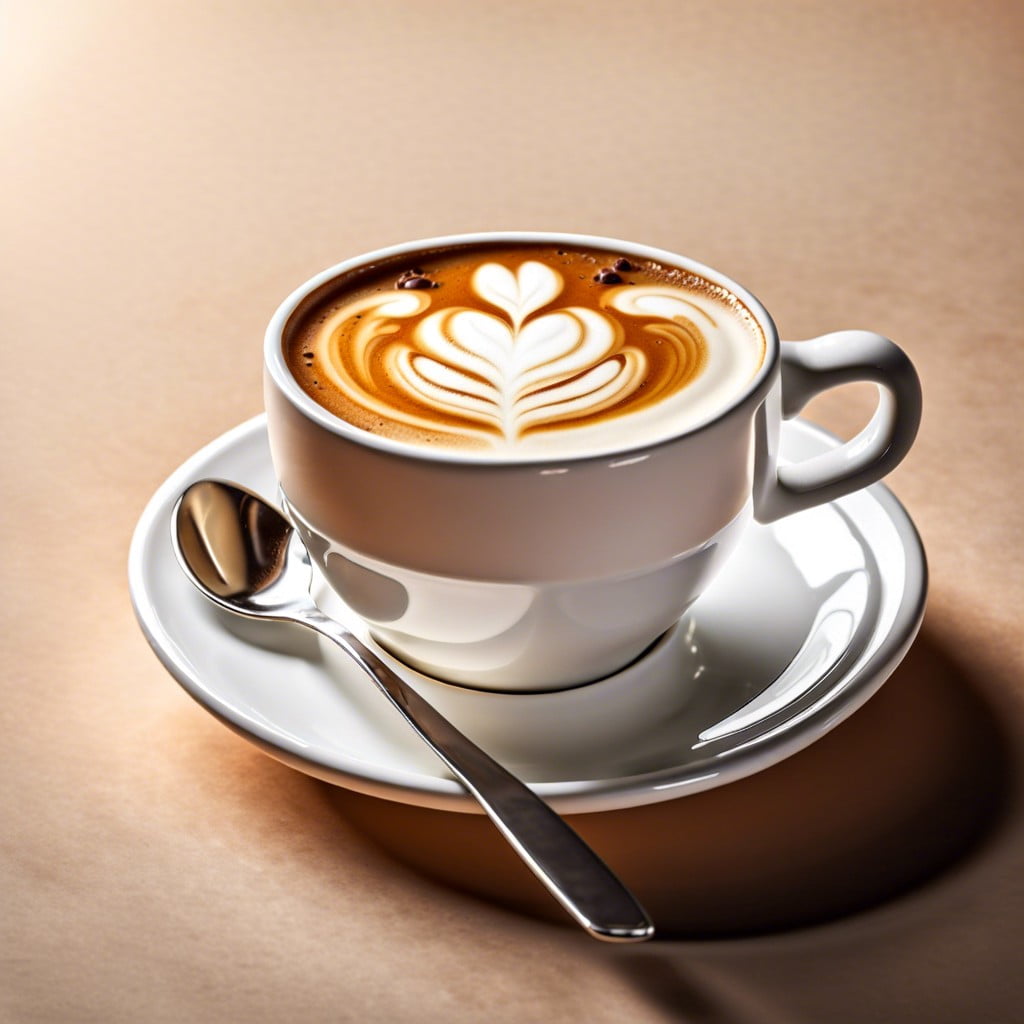Learn what sets a flat white coffee apart as we clarify its components, preparation, and taste profile.
The Origin of the Flat White

Legend and lore swirl in steaming cups when tracing the roots of this popular espresso drink. Some say it sprouted in the 1980s from the coffee-savvy shores of Australia, while others swear by its New Zealand heritage, where it emerged as a proud Kiwi creation. What’s certain is that the Southern Hemisphere birthed the flat white, a child of the booming coffee culture that gripped both nations.
In Sydney or Wellington alike, the quest for a richer, creamier espresso concoction led to the development of this ambrosial beverage. It slinked its way into café menus as a smoother, velvety alternative to the frothier cappuccino. Competing claims from both countries have yet to percolate into consensus, but regardless of its geographical cradle, the flat white sailed across oceans, winning over palates and establishing itself as a mainstay in coffeehouses worldwide. With a dedicated following from Auckland to London and San Francisco, its journey from down under to global sensation cements its place in the coffee lexicon.
Flat White Ingredients and Equipment
To whip up a stellar flat white, you’ll need two prime components: espresso and milk. Let’s break it down:
First, espresso: the backbone of your drink. For the best shot, high-quality, fresh espresso beans are your golden ticket. Grind them fine, but not too powdery, and aim for a rich, robust flavor profile that can stand up to milk without getting lost.
Then there’s the milk. Full-fat milk steals the show here, providing creaminess and a velvety texture. Heat it to about 60-65°C (140-149°F) for that perfect microfoam – silky and glossy, not too stiff or airy.
And let’s talk equipment. You’ll want a reliable espresso machine with a steam wand to nail the milk’s consistency. A milk jug with a narrow spout gives you more control for pouring the microfoam. Lastly, don’t overlook the cup – a small, 150-160ml ceramic cup is your canvas for this caffeinated masterpiece.
How to Make a Flat White
Start with a good quality espresso shot as the base. Aim for a rich and robust flavor. For a standard flat white, you’ll pull a double shot. Ensure your coffee beans are ground to a fine espresso consistency and firmly tamped for optimal extraction.
Heat your milk to about 60–65°C (140–149°F). Use whole milk if possible—the fat content creates a velvety texture ideal for this drink. Steam the milk to achieve a smooth, glossy microfoam, with tiny, barely-visible bubbles. Avoid creating too much foam which is more common in other espresso-based drinks like cappuccinos.
Pour the steamed milk over the espresso shot delicately. Introduction of the milk should be steady and centered, integrating with the coffee to create a uniform consistency throughout. Aim to keep the crema intact on top.
Finish with a flourish. If you’re feeling artistic, some coffee shops differentiate their flat whites with latte art, but traditionally, the focus remains on simplicity and taste over aesthetic embellishments.
What’s the Difference Between a Flat White, Cappuccino, Latte, and Cortado?
Diving into the espresso drink family, let’s sift through the froth to spot the key differences. A flat white features a double shot of espresso with a velvety, microfoam layer of milk — the hero for those craving intensity with a creamy twist.
Switching gears, a cappuccino is a frothy affair with equal parts espresso, steamed milk, and a generous cloud of foam on top. Think of it as the plush, foam-crowned cousin in the coffee clan.
A latte paints a smoother picture. It’s milder, with just one shot of espresso drowned in more steamed milk, and a modest touch of foam. It’s the comforting blanket on a chilly day.
Last but not least, the cortado, the no-frills contender, combines espresso with an equal amount of warm milk to cut the acidity, offering a bold yet balanced sip.
Each comes with its own charm, catering to different palates and moments. Whether you’re after a velvety punch or a cuddle in a cup, there’s an espresso drink waiting to greet your taste buds.
The Taste And Texture Of A Flat White
Picture velvet. That sumptuous fabric that’s both a feast for the eyes and a symphony of softness against the skin. A Flat White delivers a similar sensory experience to your taste buds. It’s where the rich espresso meets the smooth, microfoam milk, creating a harmonious blend often described as creamy with a capital ‘C’.
Sipping on this concoction, you’ll first notice a strong coffee presence, thanks to the higher ratio of espresso to milk compared to other coffee drinks. It cuts through the milk but doesn’t overpower it, setting the stage for a warm, comforting hug of flavors.
The texture is where the Flat White truly shines. Imagine a thin, liquid silk cascading over your tongue, a product of milk steamed to a glossy finish. It’s neither too frothy nor too flat – the microfoam lifts the espresso without eclipsing it, ensuring a consistent texture from the first sip to the last.
When done right, the Flat White comes alive with a natural sweetness brought about by the milk’s temperature, allowing those subtle caramel notes from the espresso to dance through without a hint of bitterness. It’s this delicate balance that makes a Flat White an understated masterpiece of coffee craft.